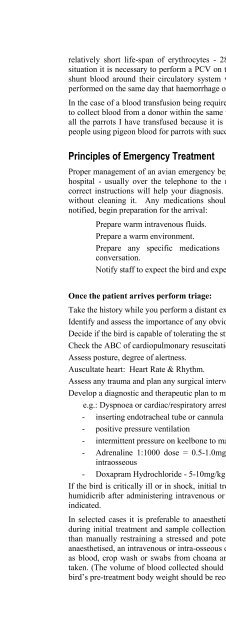Handling and Nursing Reptiles - Australian Veterinary Association
Handling and Nursing Reptiles - Australian Veterinary Association
Handling and Nursing Reptiles - Australian Veterinary Association
You also want an ePaper? Increase the reach of your titles
YUMPU automatically turns print PDFs into web optimized ePapers that Google loves.
elatively short life-span of erythrocytes - 28 to 45 days. To assess the true blood loss<br />
situation it is necessary to perform a PCV on the day after the blood loss occurs, as they can<br />
shunt blood around their circulatory system very effectively giving rise to a false PCV if<br />
performed on the same day that haemorrhage occurs.<br />
In the case of a blood transfusion being required, it is commonly accepted that it is preferable<br />
to collect blood from a donor within the same taxonomic group. I have used Galah blood for<br />
all the parrots I have transfused because it is easily obtainable. There have been reports of<br />
people using pigeon blood for parrots with success <strong>and</strong> no complications.<br />
Principles of Emergency Treatment<br />
Proper management of an avian emergency begins with the initial contact with the veterinary<br />
hospital - usually over the telephone to the receptionist. Careful questioning <strong>and</strong> relaying<br />
correct instructions will help your diagnosis. The client should bring the bird in the cage<br />
without cleaning it. Any medications should also be brought in. Once you have been<br />
notified, begin preparation for the arrival:<br />
Prepare warm intravenous fluids.<br />
Prepare a warm environment.<br />
Prepare any specific medications or equipment indicated by the telephone<br />
conversation.<br />
Notify staff to expect the bird <strong>and</strong> expedite its admission.<br />
Once the patient arrives perform triage:<br />
Take the history while you perform a distant examination of both the bird <strong>and</strong> the cage.<br />
Identify <strong>and</strong> assess the importance of any obvious or acute problems.<br />
Decide if the bird is capable of tolerating the stress of restraint <strong>and</strong> close examination.<br />
Check the ABC of cardiopulmonary resuscitation: Airway, Breathing <strong>and</strong> Circulation.<br />
Assess posture, degree of alertness.<br />
Auscultate heart: Heart Rate & Rhythm.<br />
Assess any trauma <strong>and</strong> plan any surgical intervention required.<br />
Develop a diagnostic <strong>and</strong> therapeutic plan to match patient’s condition<br />
e.g.: Dyspnoea or cardiac/respiratory arrest – consider:<br />
- inserting endotracheal tube or cannula into caudal abdominal air sac<br />
- positive pressure ventilation<br />
- intermittent pressure on keelbone to massage heart<br />
- Adrenaline 1:1000 dose = 0.5-1.0mg/kg intravenous, intratracheal, intracardiac or<br />
intraosseous<br />
- Doxapram Hydrochloride - 5-10mg/kg intravenous, Intramuscular or subcutaneous<br />
If the bird is critically ill or in shock, initial treatment is only supportive. Place the bird in a<br />
humidicrib after administering intravenous or subcutaneous fluids <strong>and</strong> other medications as<br />
indicated.<br />
In selected cases it is preferable to anaesthetise the bird with Isoflurane to minimise stress<br />
during initial treatment <strong>and</strong> sample collection. In my opinion, the use of Isoflurane is safer<br />
than manually restraining a stressed <strong>and</strong> potentially compromised patient. Once the bird is<br />
anaesthetised, an intravenous or intra-osseous catheter can be applied, <strong>and</strong> other samples such<br />
as blood, crop wash or swabs from choana <strong>and</strong>/or cloaca can be collected, <strong>and</strong> radiographs<br />
taken. (The volume of blood collected should not exceed 1% of the bird’s bodyweight). The<br />
bird’s pre-treatment body weight should be recorded.

















